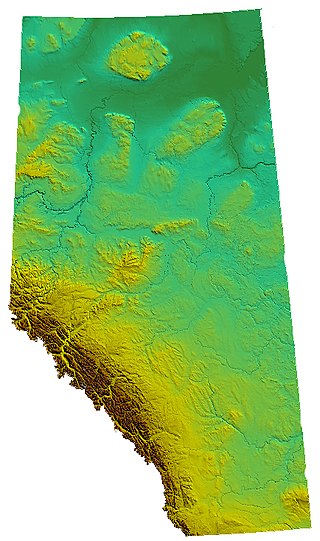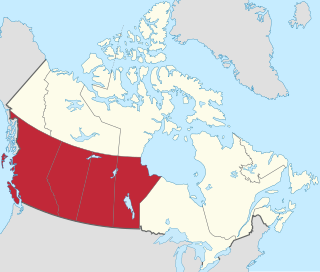Related Research Articles

Canada has a vast geography that occupies much of the continent of North America, sharing a land border with the contiguous United States to the south and the U.S. state of Alaska to the northwest. Canada stretches from the Atlantic Ocean in the east to the Pacific Ocean in the west; to the north lies the Arctic Ocean. Greenland is to the northeast with a shared border on Hans Island. To the southeast Canada shares a maritime boundary with France's overseas collectivity of Saint Pierre and Miquelon, the last vestige of New France. By total area, Canada is the second-largest country in the world, after Russia. By land area alone, however, Canada ranks fourth, the difference being due to it having the world's largest proportion of fresh water lakes. Of Canada's thirteen provinces and territories, only two are landlocked while the other eleven all directly border one of three oceans.

A Foehn or Föhn, is a type of dry, relatively warm, downslope wind that occurs in the lee of a mountain range. It is a rain shadow wind that results from the subsequent adiabatic warming of air that has dropped most of its moisture on windward slopes. As a consequence of the different adiabatic lapse rates of moist and dry air, the air on the leeward slopes becomes warmer than equivalent elevations on the windward slopes.

Alberta is one of the thirteen provinces and territories of Canada. Located in Western Canada, the province has an area of 661,190 km2 (255,290 sq mi) and is bounded to the south by the United States state of Montana along 49° north for 298 km (185 mi); to the east at 110° west by the province of Saskatchewan for 1,223 km (760 mi); and at 60° north the Northwest Territories for 644 km (400 mi). The southern half of the province borders British Columbia along the Continental Divide of the Americas on the peaks of the Rocky Mountains, while the northern half borders British Columbia along the 120th meridian west. Along with Saskatchewan it is one of only two landlocked provinces or territories.

Orographic lift occurs when an air mass is forced from a low elevation to a higher elevation as it moves over rising terrain. As the air mass gains altitude it quickly cools down adiabatically, which can raise the relative humidity to 100% and create clouds and, under the right conditions, precipitation.

Chinook winds, or simply Chinooks, are two types of prevailing warm, generally westerly winds in western North America: Coastal Chinooks and interior Chinooks. The coastal Chinooks are persistent seasonal, wet, southwesterly winds blowing in from the ocean. The interior Chinooks are occasional warm, dry föhn winds blowing down the eastern sides of interior mountain ranges. The coastal Chinooks were the original term, used along the northwest coast, and the term in the interior of North America is later and derives from the coastal term.

The Canadian Junior Hockey League (CJHL) is an association of Canadian junior A ice hockey leagues and teams and was formed in November 1993, emerging from the Canada West Association of Junior 'A' Hockey. The champion of the Canadian Junior Hockey League wins the Centennial Cup.

Canadian wine is wine produced in Canada. Ontario and British Columbia are the two largest wine-producing provinces in Canada, with two-thirds of Canada's vineyard acreage situated in Ontario. However, wine producing regions are also present in other provinces, including Alberta, Quebec, New Brunswick and Nova Scotia.
Expenditures by federal and provincial organizations on scientific research and development accounted for about 10% of all such spending in Canada in 2006. These organizations are active in natural and social science research, engineering research, industrial research and medical research.
Crown corporations in Canada are government organizations with a mixture of commercial and public-policy objectives. They are directly and wholly owned by the Crown.
Coal reserves in Canada rank 13th largest in the world at approximately 10 billion tons, 0.6% of the world total. This represents more energy than all of the oil and gas in the country combined. The coal industry generates CDN$5 billion annually. Most of Canada's coal mining occurs in the West of the country. British Columbia operates 9 coal mines, Alberta nine, Saskatchewan three and New Brunswick one. Nova Scotia operates several small-scale mines, Westray having closed following the 1992 disaster there.

Western Canada, also referred to as the Western provinces, Canadian West or the Western provinces of Canada, and commonly known within Canada as the West, is a Canadian region that includes the four western provinces just north of the Canada–United States border namely British Columbia, Alberta, Saskatchewan and Manitoba. The people of the region are often referred to as "Western Canadians" or "Westerners", and though diverse from province to province are largely seen as being collectively distinct from other Canadians along cultural, linguistic, socioeconomic, geographic and political lines. They account for approximately 32% of Canada's total population.

The 2012 Scotties Tournament of Hearts, the Canadian women's national curling championship, was held from Saturday, February 18 to Sunday, February 26 at the ENMAX Centrium in Red Deer, Alberta. This Tournament of Hearts marked the second time that Red Deer has hosted the Scotties; the first time that the Scotties was hosted in Red Deer was in 2004.
This is a list of elections in Canada scheduled to be held in 2017. Included are provincial, municipal and federal elections, by-elections on any level, referendums and party leadership races at any level.
The following television stations broadcast on digital or analog channel 12 in Canada:
The following television stations broadcast on digital or analog television channel 13 in Canada:
References
- ↑ "Cross Country Skiing in Illinois". A1 Trails. Archived from the original on 2008-05-09. Retrieved 2012-10-13.
- 1 2 "Colorado Fishing Network: Banana Belt Trout - Arkansas River". Coloradofishing.net. Retrieved 2012-10-13.
- ↑ "Parks Canada - Point Pelee National Park - Weather". Pc.gc.ca. 2009-08-24. Retrieved 2012-10-13.
- ↑ Gayler, Hugh J. (1994). Niagara's Changing Landscapes. McGill-Queen's Press - MQUP. ISBN 9780886292355.
- ↑ "Big banana ups Manitoba town's 'a-peel' - Manitoba - CBC News". Cbc.ca. 2010-08-03. Retrieved 2012-10-13.
- ↑ "Salt Spring Island, Canada's Banana Belt". Saltspringmarket.com. 2012-09-13. Retrieved 2012-10-13.
- ↑ "Bananas and olives now thriving in the Banana Belt of Canada | the Province". 2016-09-06.
- ↑ "International Plowing Match, Day 4: 70 crops 'in the raw state' on display | the London Free Press". 2018-09-21.
- ↑ "Almost 70 crops shown in 'raw state' at IPM". 2018-09-21.
- ↑ Canfield, Jack; Hansen, Mark Victor; Newmark, Amy (5 November 2013). Chicken Soup for the Soul: O Canada the Wonders of Winter: 101 Stories about Bad Weather, Good Times, and Great Sports. Simon and Schuster. ISBN 9781611592313.
- ↑ MotorBoating. March 2002.
- ↑ Murphy, Peter (4 November 2009). The Business of Resort Management. Routledge. ISBN 9781136359361.
- ↑ "Rare and unusual plant sale's a draw for Nova Scotia town". 20 June 2017.
- ↑ Feliciter. 1974.
- ↑ Ontario Library Review. 1974.
- ↑ Wall, Karen L. (19 October 2012). Game Plan: A Social History of Sport in Alberta. University of Alberta. ISBN 9780888645944.
- ↑ Jones, David C. (2002). Empire of Dust: Settling and Abandoning the Prairie Dry Belt. University of Calgary Press. ISBN 9781552380857.
- ↑ Hardy, William George (1967). "lethbridge"+banana+belt Alberta: A Natural History.
- ↑ Roberge, Earl (1985). Columbia: Great River of the West . Chronicle Books. ISBN 9780877013365.
Banana belt.
- ↑ "Observatório da Emigração".
- ↑ https://www.kootenaivalleytimes.com/boundary/weather-outlook-creston-best-in-the-metro-for-sun-bathing/article_34830faa-35e0-11ea-9143-6b0c38b9d68d.html.
{{cite web}}: Missing or empty|title=(help) - ↑ "Hunt's Guide to Michigan's Upper Peninsula". Hunts-upguide.com. 1997-02-26. Retrieved 2012-10-13.
- ↑ Wechter, Eric B. (2008). Fodor's Pacific Northwest, 17th Edition - Fodor's - Google Books. Fodor's Travel Publications. ISBN 9781400007332 . Retrieved 2012-10-13– via Google Books.
- ↑ "Wine, Water and History: Exploring Idaho's Lewis-Clark Valley". 19 November 2021.
- ↑ "Treasure Valley: Boise and Beyond".
- ↑ Don White (June 2023). "Rain Shadows". Willy Weather. Retrieved 25 May 2024.
- ↑ Joel Pippard (16 April 2020). "Rain one side, heat the other in NSW". Weatherzone . Retrieved 25 May 2024.